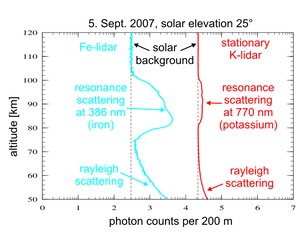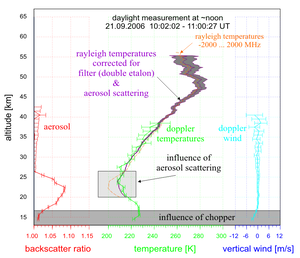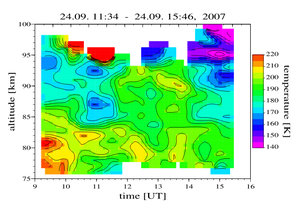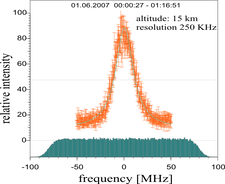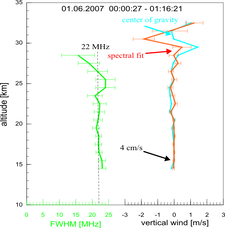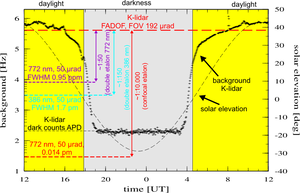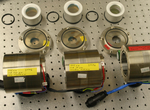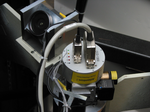The mobile Fe lidar
Lidar observations at daylight are challenging because the weak signal from the mesosphere is blurred by solar radiation. For daylight observations narrow band spectral filters have been developed in the past and are part of the IAP lidars. Nowadays spectral filtering allows valuable measurements at daytime, see, e.g., "Temperature and wind soundings" und "Atmospheric tides". Nevertheless the quality of such measurements is far behind the capabilities of lidar at night time. Regardless of the complex spectral filtering all measurements at daytime suffer from a 10000 times higher background compared to night time observations which cannot be rejected by spectral filtering alone.
For improved measurements at daytime the IAP developed a mobile iron Doppler lidar (Fe lidar). Beside narrow band spectral filtering with a double etalon the background is reduced by an extreme small field of view of the receiving mirror. The extreme small field of view requires a diffraction limited and spatial very stable laser. Each laser pulse is stabilised in the field of view by a fast and precise beam stabilisation system (0.0003 degree). The small field of view is the base for the construction of efficient and almost lossless spectral filters of small sizes. Altogether the Fe lidar achieves an approx. 100 times lower background with similar signal strength compared to the stationery K lidar which applies an equivalent spectral filter (Figure 1).
The determination of Doppler temperatures requires additionally a precise knowledge of the spectral dependency of the instrument. With a new approach this information can be derived from the backscattered Rayleigh/aerosol signal from the stratosphere. Additionally the contribution of aerosols to the signal and the Doppler width (temperature) and Doppler shift (vertical motion/wind) can be derived from the Rayleigh/aerosol scattering at these altitudes (Figure 2).
The Fe lidar applies this technique at the 386 nm iron resonance line and also at the fundamental wavelength of the pulsed alexandrite laser at 772 nm. Whereas the 386 nm focuses on temperature measurements at the mesosphere (Figure 3) the 772 nm is used for the examination of ice particles at the mesopause. With an additional confocal etalon, background free observations of ice particles and aerosols are possible at daytime. Simultaneously the interfering Rayleigh signal is rejected due to 100 times smaller spectral width allowing the observation of smaller ice particles in the future. The narrow band spectral filtering achieved by this technique allows secondary a precise determination of the Doppler shift (vertical motion/wind of aerosols and ice particles).
Figure 4 shows the backscattered signal from stratospheric aerosols. From the Doppler shift of such spectra the vertical motion of aerosols are calculated and shown in Figure 5. The observed spectral width is mainly given by the instrument and includes in particular the properties of the confocal etalon and the laser system. In future this technique will be applied for mesospheric ice particles which can show vertical motions in the order of several m/s.
Figure 6 shows the solar background of the stationary K lidar for a single day and in comparison the background for different channels of the Fe lidar. The receiver is compact enough for the installation in the mobile Fe lidar despite of the complex technique with 5 etalons and 8 receiving channels (see above). The design of the instrument allows in the future performing all measurements simultaneously.
Publications
- R. Wörl, B. Strelnikov, T. P. Viehl, J. Höffner, P.-D. Pautet, M. J. Taylor, Y. Zhao und F.-J. Lübken, Thermal structure of the mesopause region during the WADIS-2 rocket campaign, Atmos. Chem. Phys., 19, 77-88, doi:10.5194/acp-19-77-2019, 2019.
- T. P. Viehl, J. M. C. Plane, W. Feng und J. Höffner, The photolysis of FeOH and its effect on the bottomside of the mesospheric Fe layer, Geophys. Res. Lett., 43, 1373-1381, doi:10.1002/2015GL067241, 2016.
- J. Höffner und J. Lautenbach, Daylight measurements of mesopause temperature and vertical wind with the mobile scanning iron lidar, Opt. Lett., 34, 1351-1353, 2009.












